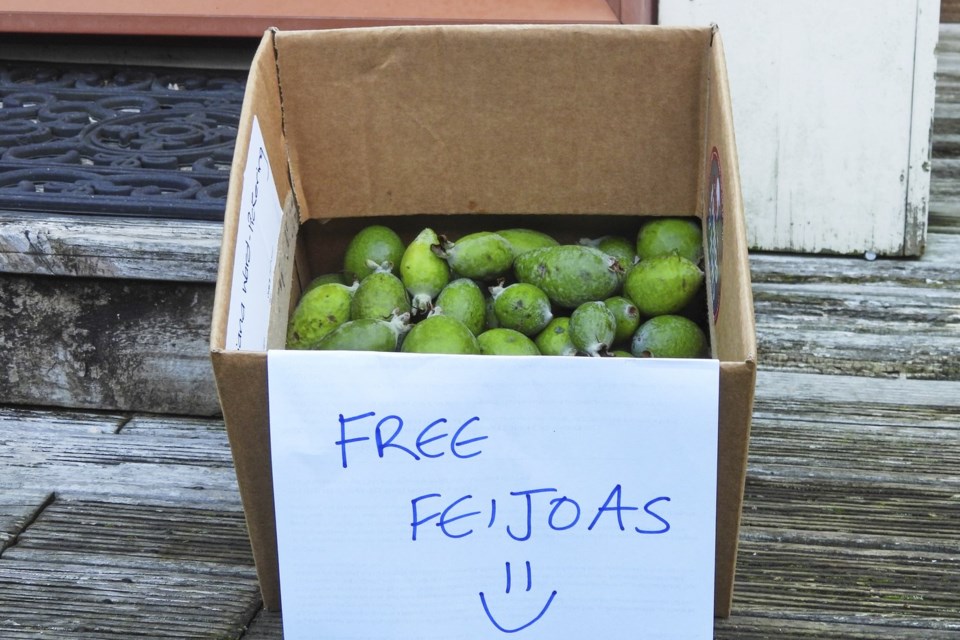WELLINGTON, New Zealand (AP) ŌĆö The unofficial national fruit of isnŌĆÖt native to the country ŌĆō itŌĆÖs South American. It isnŌĆÖt exclusively found in New Zealand. And itŌĆÖs not, perhaps surprisingly, the kiwi. ItŌĆÖs the feijoa.
Known as pineapple guava elsewhere, the fruit ŌĆö a green perfumed oval with a polarizing taste ŌĆö can be purchased in California or Canberra. Yet no country has embraced the feijoa with quite the fervor or the fixation of New Zealanders.
Due to its short shelf life, New Zealand ŌĆö a nation of thriving fruit exports ŌĆö has never been able to spin the feijoa (pronounced fee-jo-ah) into a global brand, as growers have done with apples and kiwi. But during the brief span of weeks each year when the fruit is ripe, the country goes feijoa wild.
A backyard boom
The feijoaŌĆÖs allure comes partly from how itŌĆÖs acquired. In autumn, fallen fruit forms fragrant carpets beneath backyard trees and is swept into boxes, bags and buckets to be offered for free outside homes, in office breakrooms and on neighborhood Facebook groups. There's such abundance that some feijoa lovers take pride in never having paid for one.
ŌĆ£ItŌĆÖs sort of non-commercialized. We turn up our noses at the idea of buying them in the shop,ŌĆØ said Kate Evans, author of the book Feijoa: A Story of Obsession and Belonging. ŌĆ£You just sort of expect to get them for free.ŌĆØ
In suburban Wellington, Diana Ward-Pickering said she had given away ŌĆ£thousandsŌĆØ of feijoas from her five backyard trees this season: in a box on the sidewalk, to neighbors, to coworkers, to her daughterŌĆÖs eyelash technician ŌĆö in short, to any friend or stranger who wanted some.
On a recent Sunday, Ward-Pickering selected a feijoa from dozens on the ground, halved it with a spoon, and scooped the pale, creamy flesh into her mouth.
ŌĆ£Delicious,ŌĆØ she said. But while she could eat a kilogram (2.2 pounds) of the fruit in a sitting, she said, even her appetite couldn't keep up with the sudden and generous bounty that arrives each April.
ŌĆ£There are people who canŌĆÖt afford to pay for them,ŌĆØ Ward-Pickering said. ŌĆ£We happily give them away.ŌĆØ
Love it or hate it
Not everyoneŌĆÖs an enthusiast, and every New Zealander has an opinion. What devotees of the fruit savor as a distinctive texture, flavor and smell, is gritty, soapy or sour to others.
Diana Ward-PickeringŌĆÖs daughter, Lizzy, gingerly slurped a piece of feijoa into her mouth and grimaced.
ŌĆ£ItŌĆÖs giving snot,ŌĆØ she said. ŌĆ£My mind has not changed.ŌĆØ
But for New Zealanders abroad who love the fruit, feijoas are a nostalgic taste evocative of a kiwi childhood. Evans, who admitted to once paying 3 Australian dollars ($1.90) for a single feijoa at a market in Australia, said that in 12 years living overseas she often saw expatriates asking the same question online: Where can I find feijoas?
A strange history
How a fruit that hails from the highlands, and a corner of first came to New Zealand remains something of a mystery, Evans said. But whatŌĆÖs known is that feijoas have been in New Zealand for just over 100 years, probably originating from California, via Australia.
The trees grow ŌĆ£extremely wellŌĆØ in New Zealand, growers say, due to the soil, subtropical climate and relative lack of destructive insect species.
In spite of New ZealandŌĆÖs booming backyard feijoa economy thereŌĆÖs still demand for them in stores, where they are currently sold for about 9 to 10 New Zealand dollars ($5-6) per kilogram. There are about 100 commercial feijoa growers in New Zealand almost solely supplying the domestic market, including for popular beverages such as feijoa cider, kombucha and juice.
But exporting the fruit is ŌĆ£tricky,ŌĆØ said Brent Fuller, spokesperson for the New Zealand Feijoa Growers Association. ŌĆ£TheyŌĆÖll keep in the chiller for two or three weeks, but thatŌĆÖs about it.ŌĆØ
Research is underway to increase the shelf life of the fruit. But with the name feijoa still unknown abroad, it remains for now an institution of New Zealand's autumn.
ŌĆ£ItŌĆÖs something that kind of bonds us and gives us an excuse to talk to people around us,ŌĆØ Evans said. The kiwi, she added, has been a lucrative export for New Zealand.
ŌĆ£But we donŌĆÖt love it the way that we love feijoas.ŌĆØ
Charlotte Graham-mclay, The Associated Press



